Espace Multimédia Gantner – Belfort – Opening on the 14th of October 2023
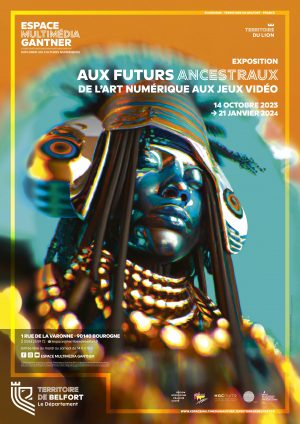
« When we say that the future is ancestral, it has more to do with DNA than genealogy. It’s worldview: it’s the ability to go back to an event that created the world and is alive in you. We want a constant creation of everything and ourselves. This is what happens in DNA, the code handed down by our ancestors. This can reintroduce us to the constellation of life within the planet, where we stop being specialists and realize that we have a common origin ». Ailton Krenak, philosopher and leader of the Brazilian indigenous Krenak movement and author of the book Futuro Ancestral en 2021
The global games market is still dominated by Europe, the United States and Japan.The exhibition « Aux futurs ancestraux » adopts a decolonial perspective on art and games in order to echo works conceived on the periphery of this global and globalizing culture. « Aux futurs ancestraux » immerses us in other types of representations, cities, landscapes, narratives and cosmogonies, conceived and expressed in other languages, and seeks to decolonize our imaginary through the co-construction of narratives born of the encounter between oral tradition, endogenous knowledge and the virtual universes of video games.
This necessary dialogue between these different modes of knowledge requires a paradigm shift. Science and human thought are no longer the only sources of knowledge; it is now possible to think of knowledge « beyond the human » (Eduardo Kohn). « This implies that nature thinks, that animals think, and that non-humans can teach us techniques and knowledge, by changing our perspective. (Viveiro de Castro).
Between photo installations, drawing, performance, video installations, immersive, interactive and video game, an exhibition that invites us to reconnect with what connects us to our ancestral futures: the living.
:quality(85)/cloudfront-us-east-1.images.arcpublishing.com/infobae/UQ76YOQIIJGIHCDUTHMLAQDU3M.png)
Artists
High in the Sky and Beneath the Stars, Laura Palavecino, (AR), interactive installation
Laidaxai, Daniela Fernandez, (AR) video game
Paramo, Eulalia De Valdenebro Cajiao, (CO), Installation drawings video
Water Divinity, Henri Tauliaut (Martinique), Video game
Atuel, Matajuegos, (ARG), Video game
Coca para comer, Aniara Rodado, (CO), Installation, Performance
Epiculus Garden, Tania Fraga, (BR), Video Installation
Liquid Forest, Isabelle Arvers (FR) Machinima Gaël Manangou, Sound creation (RDC)
Spectographie, VR film & installation : Carole Chausset Myriam Mihindou &Annie-Flore Batchiellilys, Daniely Francisque, Florence boyer / cie Artmayage
eFa, interactive installation by Technorisha Collective: Livia Diniz, Benjamin Abras, Bruno Creuzet, Michel Petris, Henri Tauliaut, M’vwâma Diop, Annabel Gueredrat, Isabelle Arvers.
La Puissance des arbres, vidéo portaits directed by Isabelle Arvers, Livia Diniz, Marco Gual
Atuel a video game by Matajuegos, Argentina, 2022
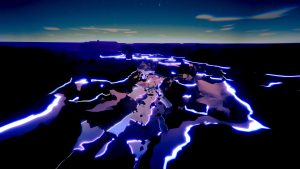
Matajuegos is an Argentine independent game cooperative, creating Latin American games that open up social, political and cultural perspectives. Formed in 2015 by Santiago Franzani and Pablo F. Quarta, the group explores issues of labor, gender, art, politics and regional identity.
A documentary video game dealing with the climate crisis, Atuel was born as a complement to the documentary film of the same name, which focuses on the realities of contemporary life in the Atuel River Valley in Argentina, in the context of the water crisis caused by climate change. Throughout the film and game, we hear the voices of local geologists, historians, biologists, lawyers and artisans, who testify to their knowledge and experiences of this region. In this way, Atuel evokes the natural and cultural identity of the region, providing insight into its past, present and future, while connecting its internal conflicts with the global issues of climate change and landscape preservation.
Although the topography of the game Atuel is inspired by the real landscape of the river and its region, it differs from the film by its dreamlike and surreal qualities. During a game, the players are invited to incarnate the Atuel river. Through this metamorphosis, the game allows to consider non-human perspectives – in particular those specific to the territory’s fauna -, but also to (re)discover the intimate relationship that links human societies to rivers. In this sense, the Atuel game highlights the interconnectedness of the elements of an ecosystem that extends from the river, while showing how climate change is affecting and vulnerabilizing the relationships that human societies have with their place.
Laidaxai, a video game by Daniela Fernandez, Argentina, 2021
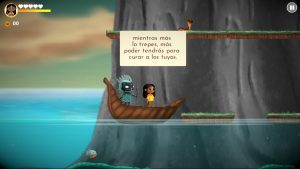
Daniela Fernandez is an Argentinian illustrator and designer of images and sounds. A member of the group of dissident women in the Argentinian video game sector since 2018, she develops video games from a decolonial, feminist and non-violent perspective.
Daniela Fernandez works from stories told in her family with a diverse cultural mix (Spanish, French, Guarani and Argentinian). As a designer, she tries to tell stories – especially those of indigenous peoples – as her ancestors did, but through video games.
In 2020, she developed and directed, Laidaxai, The Black Tree, a video game inspired by the story of the Primordial Tree of the Toba-Chaqueno people of Qom, with the help of community members from the Chaco region of northern Argentina. In the game, the protagonist Laidaxai must save her community from a strange disease by completing the ordeal of the Black Tree.
The Snake’s Song in High in the sky and beneath the stars, Laura Palavecino, Argentina, immersive online space, interactive installation, 2021
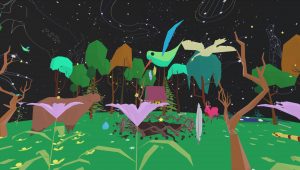
Laura Palavecino is a professor-researcher in the field of game art and an image and sound designer. Her work brings together traditional art and technology, with the aim of provoking an emotional encounter with nature through different fields of knowledge: science, ancestral stories and the humanities. Laura Palavecino, an artist from the suburbs of Buenos Aires, Argentina, describes nature as a place both inside and outside of herself. In her work, she seeks to question the boundaries between play, art, design and narrative, through projects that make visible the control of interfaces, information, contemplation and visual poetry.
The Snake’s song – High in the Sky and Beneath the Stars is a work composed of a physical installation (a space materialized by a « magic circle » that we are invited to enter) and an immersive virtual space. Conceived as a posthuman landscape, the work brings together the four elements symbolized: water, earth, air and fire.
The Snake’s Song is part of the High in the Sky and Beneath the Stars project and it proposes a first person walkable digital landscape to connect us with nature by recalling non Western sky lores, South American native species, ecological thinking and fantasy. The Snake’s Song is the virtual scenery of a techno-poetic healing ritual that refers to a landscape inspired by the formal property of the game associated with the magic circle and its ability to represent and accompany the cosmic event.In the virtual landscape, several animals stand out against the background of a starry sky: they are cardinal points that allow us to orient ourselves in the cosmos. While these species were chosen for their importance in the environment as well as in the ancestral stories told by the native people of Argentina, they are also indicators of the health of Latin American ecosystems currently threatened by deforestation, pollution, urban sprawl, monoculture and poaching. They are also a sacred value in some native cultures, notably among the Quechua, Guarani and Toba populations.
High in the Sky and Beneath the Stars connects us with the Cosmos and life on Earth, while embodying the barrier that separates us from nature as thought by Modernity.
Water Divinity, a game installation by Henri Tauliaut

Artist and researcher, Henri Tauliaut is interested in the relationship between art and science, particularly in the fields of interactive art and bio-art. He exhibits and performs in the Caribbean, South and North America, France, Senegal and China.
Henri Tauliaut considers that it is vital for the development of Caribbean cultures that the people who come from them create their own images, representations and current myths. To anchor themselves, they need ancestrality, that is to say, to recognize their dead, ancestors and deities, in order to give them back a culture that is animist or totemistic:
« In order to center ourselves, we need founding myths with which we can really identify. In order to project ourselves and propose imaginaries where we are at the center, we need Afro-futurism, Native-futurism or any other new form allowing us to offer our youth positive and utopian visions of our future.
Finally, to take care of our communities, our people, we need to reconnect with ancient therapeutic, religious and metaphysical practices by giving them a current form integrating contemporary technologies and thus creating spiritual practices such as techno-shamanism or techno-voodoo. »
The fourth and final installation in the Interfaces video game series, Water Divinity Game consists of an interactive and immersive video game and installation created between 2020 and 2022. The objective of the game is to allow viewers to encounter Afro-Caribbean water deities.
In this work, players enter the heart of the Haitian pantheon and meet various Afro-Caribbean aquatic deities from the Haitian voodoo pantheon. In the second level, which takes place underwater, players are led on a quest to uncover the hidden secrets of the Veve in space. They will find the ship Immamou, the ship of the ocean god Agwe to take them there.
View of Water Divinity, Henri Tauliaut, Martinique, video game, interactive installation, 2022
Frailejonmetría Comparada Ech 1:1, Mapa De Relaciones Táctiles Ech 1:1, drawing by Eulalia de Valdenebro Cajeao, Colombia, 2020

Popayán Visual artist (Colombia) born in 1978, Eulalia de Valdenebro Cajeo is a botanical illustrator. She is a research professor at the Universidad Nacional de Colombia, and works from the link established with the vegetal beings. Her works are part of the research-creation of her doctoral thesis in Art and Ecosophy (Paris 8 University). All of this work was carried out in the Páramo, a typical macrodiverse ecosystem of the high mountains of the intertropical Andes, located near Bogotá, at an altitude of 3000 meters.
Eulalia De valdenebro Cajeo questions her role as an artist in the face of what the philosopher Isabelle Stengers calls the « intrusion of Gaia ». This expression conveys the idea that the Earth-system dominated by modern societies reminds us (in particular through climate change) in a feedback loop making us more and more dependent on what the moderns have caused. For the artist, dealing with this intrusion involves re-evaluating and re-imagining the foundations of our thinking, our ways of doing, knowing, being and relating to natural beings and forces.
In Comparative Frailejonmetry and the Map of Tactile Relationships, the artist worked with frailejones (Espeletia grandiflora, family Asteraceae), emblematic plants of the Colombian páramos, which have the aesthetic power to resemble human beings, while critically seizing botanical illustration and herbarium specimens.
In these artistic practices, she uses her body as a unit of measurement and displaces her condition as a human being (subject) in relation to the plant (object). By using the same methods of study for her body as for the plant, she is in effect on the same plane of representation. This idea is also found in the series Corpsperméables, through work done in situ.
Epiculus Garden, a generative video installation by Tania Fraga, Brazil, 2017
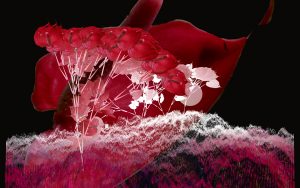
Tania Fraga is an architect, computer artist and researcher using brain-computer interfaces within immersive interactive environments. She creates virtual reality customized software for site specific installations looking for symbiosis among humans and computers. In her work, she seeks to create virtual and material realities through the integration of art, science and technology. Numbers, which she considers as sensitive expressions of a sublime and transcendental dream world, have an important place in her work.
Originally, Epicurus Garden was an interactive, non-repetitive video installation based on mathematical data resulting from the analysis of the viewer’s brain activity through an EEG headset (a device that measures the electrical activity of the brain, electroencephalogram). The behaviors of the plants present in the video were thus affected by the mathematical interpretation of the viewer’s emotions, thus conferring on the virtual agents a form of autonomy. In this way, Tania Fraga seeks to create what she calls an « exo-endogenous » interaction, that is to say a form of symbiosis where human and virtual behaviors respond to each other.
In the exhibition Aux Futurs Ancestraux, the video presented is no longer directly connected to a human brain through an EEG headset. Programmed in Java, the behaviors of the plants in Epicurus’ Garden are nevertheless the result of the artist’s attempt to compose a world similar, albeit simplified, to nature and life: it is the sound and visual expression of a fluid mathematical universe.
eFa, interactive installation by Technorisha Collective: Livia Diniz, Benjamin Abras, Bruno Creuzet, Michel Petris, Henri Tauliaut, M’vwâma Diop, Annabel Gueredrat, Isabelle Arvers, 2023
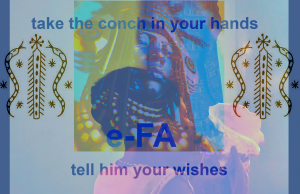
Working on the FA echoes the issues of the Technorisha workshop, aiming to develop artistic and
spiritual practices such as techno shamanism and techno-voodoo.
The West African divination technique of FA fascinates us because of its visual proximity to binary
computer code.
The interactive installation, Efa DC, immerses the viewer in a poetic universe, where arts,
technology and spirituality are closely intertwined. She offers him a multisensory ritual, where
playfulness rubs shoulders with secrets in a sensitive and current stroll.
Liquid forest, machinima by Isabelle Arvers, sound by Gaël Manangou, 10.56′, 2023
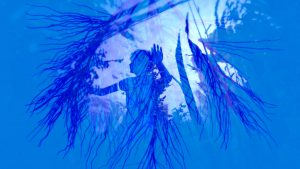
« Does the white man really not know that if he destroys the forest, the rain will stop? And that if the rain stops, he won’t have anything to eat or drink? David Kopenawa*, Yanomami activist philosopher, quoted by scientist Antonio Donato Nobre in a TEDxAmazonia** who explains how each tree « sweats » releasing more than 1,000 liters of water into the atmosphere every day, becoming a vertical river. If there are no more forests, there will be no more water. The baobabs in West Africa, but also in Madagascar, are disappearing. And these trees, whose spongy wood makes them perfect receptacles for the community’s water, which turns them into cistern trees, have been dying for the last ten years. Liquid Forest plunges you into these vertical rivers, inviting you to swim in the baobabs, in the corals and to immerse yourself in a gender fluid way, in a universe that is more than binary and in realities that are more than multiple, because everything is interconnected.
* La chute du ciel a book by David Kopenawa
** Há um rio sobre nós, Antonio Donato Nobre conference, TEDxAmazonia 2010
Coca para comer, Aniara Rodado, video installation, leaf carpet, Colombia, 2023
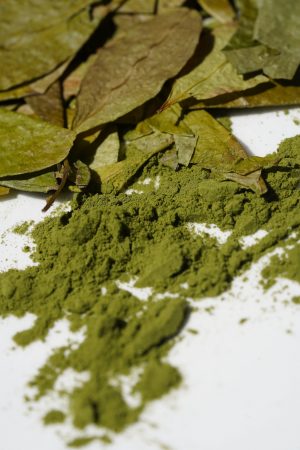
Choreographer, artist and researcher, Aniara Rodado explores witchcraft and interspecific relationships from the plant world, from a trans-feminist perspective. Her practice questions the current context of ecological crisis and techno-scientific fetishization. The tendency to standardize the various forms of life, at all scales, affects bodies as well as alliances and knowledge.
In the video installation Coca para comer, Aniara Rodado makes the coca leaf « travel » and « speak ». Considered sacred, the coca leaf has been used in the Andean region for 8000 years for its cultural, ritual, nutritional and medicinal functions.
The coca is not the drug cartels, nor the hyperproductive capitalism. It is not deforestation and glyphosate sprayed from airplanes onto the dead soil and contaminated rivers of Colombia, nor is it the war on drugs, nor is it the last gasp of the people enslaved for centuries in the silver mines of Potosi. It has never been anything but the luxury of the Inca elites.
Through this work, Aniara Rodado tries to alert us to the danger of demonizing plants that heal, nourish or « drug », and with which entire peoples have collectively built epistemologies, ontologies and ecologies.
For her, the process of turning a sacred plant into an illicit commodity amounts to committing epistemicides and, therefore, to taking part in the witch hunt, which aims to break the links between communities, their knowledge and their lands.
La puissance des arbres, a film by Isabelle Arvers (FR), Livia Diniz (BR) and Bruno Qual (BR), 2023

In Wolof, the word Garab means both tree and medicine. This documentary is a journey to discover ancestral knowledge related to the power of trees and their role in environmental challenges, through interviews with artists and traditional practitioners conducted by Isabelle Arvers between November 2021 and January 2022 in Senegal: Gaël Manangou, storyteller, musician and initiate to the powers of trees by the Bantu in Congo; Jah Gal Doulcy, Senegalese artist and fashion designer initiated by the Diolas, the forest people of Casamance; Elon’M Tossou, Beninese Vodoun painter and Malian artist Gadabia Kodio; and traditional practitioners Ousmane Sow in Toubab Dialaw and Ismaela Cisse in Abene, Casamance, who heal with plants, bark, leaves and tree roots. By focusing on the application of ancient knowledge to contemporary issues, the film offers unique insights into the intersection of cultural understandings and ways of learning with other species and the invisible.
Spectographies: Contes de L’île étoilée, VR film & installation : Carole Chausset Myriam Mihindou &Annie-Flore Batchiellilys, Daniely Francisque, Florence boyer / cie Artmayage

A permanent filmic journey through the Sculpture Wood on Vassivière IslandSpectrographies: contes de l’île étoilée is a journey bringing together three new creations in the Sculpture Wood. Conceived by DénètemTouam Bona as a commemoration of the struggles of the colonized, this triptych invites us to plunge into the Time of Dreams, to meet spirits from the Caribbean, Equatorial Africa and the Indian Ocean who have come to re-enchant Vassivière Island, alongside pagan, indocilic spirits from Limousin. Three « cosmograms » – metal artefacts evoking the alternative worlds of different spirits – act as spatiotemporal airlocks: activating the QR codes inscribed on these works via your smartphone gives access to « spectral visions »; performances filmed in virtual reality (VR) on Vassivière Island combine ritual, dance, music and song.
Isabelle Arvers est une artiste et commissaire d’exposition française dont les recherches portent sur l’interaction entre l’art et les jeux vidéo. Au cours des vingt dernières années, elle a étudié les implications artistiques, éthiques et critiques du jeu numérique. Son travail explore le potentiel créatif du piratage des jeux vidéo à travers la pratique du machinima qui consiste à détourner des jeux vidéo pour concevoir des films. En tant que curatrice, elle se concentre sur les jeux vidéo comme médium pour les artistes. En 2019, elle embarque pour un Tour du Monde Art et Jeu Vidéo dans 17 pays des suds et écrit une thèse sur la Décolonisation de l’art et des jeux vidéo. Elle a été commissaire de plusieurs expositions et festivals à travers le monde, notamment Jibambe na Tec (Nairobi, AF, 2020), Tecnofeminismo (Bogota, AF, 2019), l’exposition de jeux politiques et sociaux Art Games World Tour pour le festival Game On! El arte del juego (Buenos Aires, 2019).
Autour de l’exposition :
– Samedi 14 octobre à 17h : rencontre avec Isabelle Arvers, commissaire de l’exposition et les artistes Aniara Rodado et Henri Tauliaut
– Dimanche 14 janvier 16h : visite guidée de l’exposition par Isabelle Arvers suivie d’une performance d’Aniara Rodado
– Les visites guidées :
Samedi 9 décembre et samedi 6 janvier à 15h par Sophie Monesi
– Les rendez-vous en ligne :
Pendant l’exposition : une série d’entretiens-portraits avec Isabelle Arvers sur la chaîne Youtube de l’EMG
À partir du 13 novembre : entretien avec Isabelle Arvers (réalisation Silvi Simon / production Espace multimédia Gantner) sur cette page et sur notre chaîne Youtube
À partir du 5 décembre : visite de l’exposition en réalité virtuelle sur cette page (conception Vincent Marguet / Espace multimédia Gantner)
